
Wetenschap
Nieuwe high-throughput sequencing-technologieën onthullen een wereld van op elkaar inwerkende micro-organismen
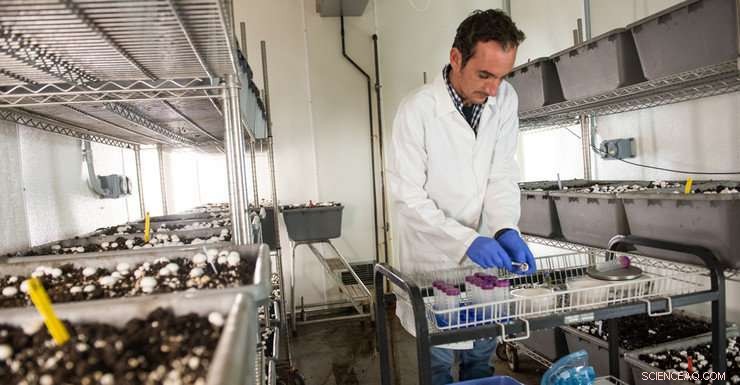
Krediet:Pennsylvania State University
Je lichaam wemelt ervan - 100 biljoen microben in je darmen, longen, mond, en huid. Je huis wemelt ervan - in toiletten en gootstenen, op tafels en stoelen, in het tapijt, en op je hond. Zelfs de grond waarop je staat wemelt van ontelbare bacteriën, schimmels, protozoa, algen, en virussen - allemaal microscopisch, allemaal onderdeel van een gemeenschap van organismen die met elkaar en met de omgeving in wisselwerking staan. Deze gemeenschappen en de omgevingen waarmee ze interageren, staan bekend als "microbiomen, " en ons groeiend begrip ervan verandert de manier waarop we ziekten behandelen, gewassen verbouwen, en maak alledaagse producten.
Het verandert hoe we naar de natuur kijken.
Wetenschappers van Penn State en het College of Agricultural Sciences lopen voorop in onderzoek naar microbiomen. Ze onderzoeken de ingewanden van mensen en dieren om te leren hoe micro-organismen de gezondheid beïnvloeden, en ze onderzoeken de bodem om te ontdekken hoe microben gewassen ten goede komen. Door dit werk krijgen de wetenschappers waardering voor de complexiteit van het microbiële leven op aarde. En ze onderzoeken ook de mogelijke voordelen en uitdagingen die deze wezens bieden.
De menselijke reis naar het rijk van het microscopische begon in 1657, toen Antoni van Leeuwenhoek, een lakenhandelaar woonachtig in Delft, Holland, onthulde dat hij had ontdekt, door te kijken door zijn zelf gecreëerde eenvoudige microscoop, kleine "dieren" die in meerwater leven.
In een brief aan de nieuw gevormde Royal Society of London, van Leeuwenhoek schreef dat deze diertjes "zo klein waren, in mijn ogen, dat ik oordeelde dat zelfs als 100 van deze zeer kleine dieren languit tegen elkaar lagen, ze konden de lengte van een korrel grof zand niet bereiken... . 't was prachtig om te zien."
Van Leeuwenhoeks ontdekking van micro-organismen betekende een ongekende verschuiving in het menselijk begrip van de natuurlijke wereld. Plotseling, het leven op aarde werd tegelijk aanzienlijk complexer en buitengewoon wonderbaarlijk. En toch, meer dan 350 jaar later, we tasten in het duister over wie veel van deze wezens zijn en wat ze doen.
"Afhankelijk van met wie je praat, we weten misschien niets over 99 procent van de micro-organismen in het milieu, " zegt Carolee Bull, hoogleraar en hoofd van de afdeling Plantenpathologie en Milieumicrobiologie. Maar, zij voegt toe, net als de verschuiving die plaatsvond nadat Van Leeuwenhoek microben ontdekte, een moderne wetenschappelijke revolutie belooft de identiteit en activiteiten te onthullen van de gemeenschappen van micro-organismen die zo'n grote invloed hebben op ons leven.
Deze keer, de tool die het allemaal mogelijk maakt, is high-throughput sequencing, ook wel next-generation sequencing genoemd. Voor het eerst beschikbaar in het jaar 2000 en pas sinds het laatste decennium op grote schaal gebruikt, de technologie kan de volgorde van nucleotiden bepalen - de As, Ts, g, en Cs - voor honderdduizenden DNA-moleculen van talloze soorten tegelijk. De technologie maakt het mogelijk om de identiteit te achterhalen van elke soort die aanwezig is in een kleine steekproef van, bijvoorbeeld, vijver water. Eenvoudige DNA-sequencing, anderzijds, is veel beperkter in zijn mogelijkheden.
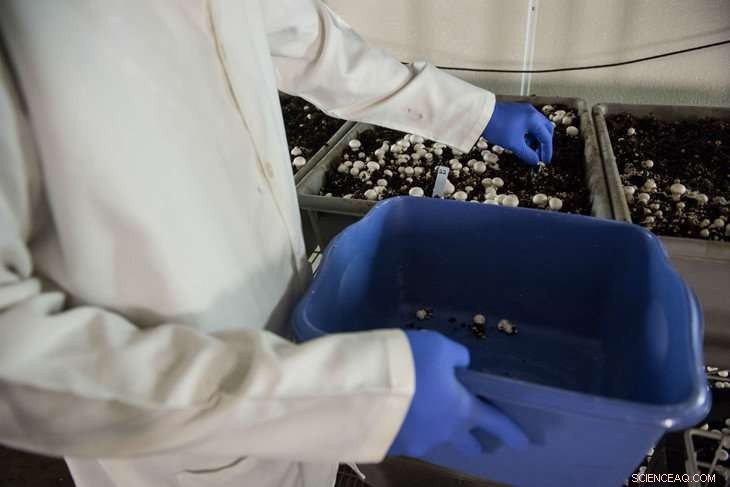
Champignons worden uit het bed gehaald, die uit drie lagen bestaat:de compost, de behuizing, en de paddestoel. bezoekende wetenschapper, Het onderzoek van Fabricio Rocha Vieira kijkt naar alternatieve materialen voor de deklaag. Zijn belangrijkste vraag is hoe alternatieve materialen de interactie van de microben met de paddenstoel veranderen. Als u dit begrijpt, heeft dit gevolgen voor de gewasopbrengsten en ook voor de voedselveiligheid. Krediet:Michelle Bixby
"Het concept van microbiomen is niet bijzonder nieuw, ", zegt Bull. "Maar met high-throughput sequencing, de zwarte doos van de microbiologie wordt eindelijk verlicht, " zegt Bull. "Het laat ons zien dat microben niet alleen werken in een vacuüm. In plaats daarvan, ze maken deel uit van een gemeenschap waarin de omgeving, andere organismen, en microben beïnvloeden en reageren op elkaar."
Waterkwaliteit beschermen en bodem herstellen
Bodemmicrobioom is een ingewikkeld studieonderwerp. Een theelepel aarde bevat waarschijnlijk een miljard individuele bacteriecellen, misschien 500, 000 schimmelfragmenten, duizenden protozoa, en wie weet hoeveel virussen, zegt Mary Ann Bruns, universitair hoofddocent ecosysteemwetenschap en -beheer. En van de bacteriën alleen, zij voegt toe, er kunnen er 10 zijn, 000 tot 20, 000 verschillende soorten.
Bruns gebruikt high-throughput sequencing, onder andere hulpmiddelen, om deze "DNA-soep, "zoals ze het noemt, die zich in de bodem bevindt. Haar onderzoek naar stikstofcyclische microben op veldschaal past in het grotere geheel van het verminderen van het transport van nutriënten naar dode kustgebieden. "Algemeen, de helft van de stikstof in kunstmest die wordt toegepast op gewassen wordt niet opgenomen door de gewassen, ' zegt ze. 'In plaats daarvan lekt het uit naar het grondwater of loopt het weg in sediment. Veel van die stikstof komt uiteindelijk terecht in de Golf van Mexico en de Chesapeake Bay, waar het ecosystemen verstoort. Ik ben geïnteresseerd in hoe we dit proces bij de bron kunnen stoppen, hoe we onze stikstoftoepassing en beheermethoden minder verspillend kunnen maken."
De sleutel, ze zegt, ligt in het vinden van stikstofbesparende plant-bodem microbiële gemeenschappen omdat ze verantwoordelijk zijn voor een groot deel van de nutriëntenkringloop in de bodem. Bijvoorbeeld, microben zetten ammonium om in nitraat, wat de gemakkelijkst verloren vorm van stikstof is. "Bepaalde microben zijn verantwoordelijk voor veel van de biochemische reacties in de bodem die resulteren in een slechte efficiëntie, ", zegt Bruns. "In de traditionele landbouw, we hebben dit probleem van stikstofverlies tegengegaan door een verzekeringsbedrag toe te voegen. Het is goedkoper en gemakkelijker om meer toe te voegen in plaats van te proberen uit te zoeken hoe verliezen in de eerste plaats kunnen worden voorkomen."
Het goede nieuws is dat hoewel sommige microben het verlies van stikstof uit de bodem bevorderen, andere soorten zijn in staat stikstof uit de atmosfeer te binden en op zijn plaats te houden. Met behulp van high-throughput sequencing, Bruns en een van haar afgestudeerde studenten karakteriseerden een mengsel van twee nauw verwante stammen van cyanobacteriën en verschillende soorten niet-fotosynthetische bacteriën die snel biofilms vormen op de bodem om erosie en afvoer te verminderen. Dit "consortium, " ze zegt, kan worden toegevoegd aan landbouwgrond om koolstof en stikstof vast te leggen en voedingsstoffen op hun plaats te houden, waardoor de behoefte aan extra stikstoftoepassingen wordt verminderd en stroomafwaartse omgevingen worden beschermd tegen stikstofverontreiniging.
Bruns zegt dat ze graag zou zien dat bedrijven interesse zouden hebben in dergelijke producten en ze zouden ontwikkelen voor gebruik in de landbouw. Bijvoorbeeld, dergelijke microbiële producten kunnen worden toegepast, samen met amendementen, om beschadigd land terug te winnen, een ander gebied waar microbioomonderzoek inzichten biedt. Bruns en postdoctoraal medewerker Claudia Rojas gebruikten next-generation sequencing om toenames van nuttige mycorrhiza-schimmels en rhizobia aan te tonen in herbegroeid mijnland na toevoeging van matige hoeveelheden compost en kalk.
Terrence Bell, universitair docent plantenpathologie en milieumicrobiologie, is ook geïnteresseerd in het creëren van microbiële consortia die aan bodems kunnen worden toegevoegd om hun functie te verbeteren. Hij richt zich op het herstel van bodems die hun microbiële activiteit hebben verloren door overmatig gebruik van meststoffen en chemicaliën. "Sommige landbouwgronden zijn uitgeput van de essentiële micro-organismen die nodig zijn voor de groei van gewassen, omdat ze zo lang zijn behandeld met chemische meststoffen, " hij zegt.
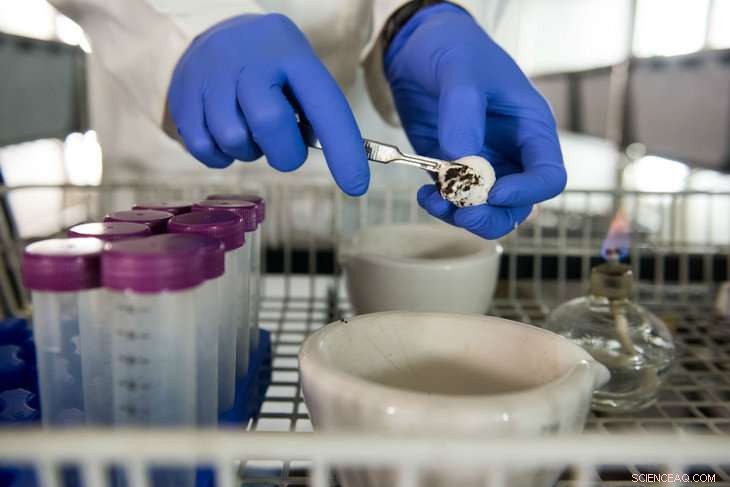
Champignons worden in plakjes gesneden om monsters te verzamelen om te testen. Krediet:Michelle Bixby
Door middel van experimentele studies, Bell en een van zijn studenten hebben aangetoond dat dit het geval is. Ze pasten verschillende soorten voedingsstoffen aan de bodem toe en ontdekten dat bodems die werden blootgesteld aan grote hoeveelheden chemisch fosfor, verschuivingen in de samenstelling van het microbioom ervoeren, waaronder een vermindering van de microbiële diversiteit, die de groei van gewassen leek te beïnvloeden.
"Onze volgende stap is om erachter te komen of we dit probleem kunnen tegengaan door microbiële diversiteit opnieuw in deze omgevingen te introduceren, ' zegt Bel.
Net als bij het onderzoek van Bruns, de taak vereist het gebruik van de nieuwste sequencing-technieken. "Het komt echt neer op de beschikbare tools, en het feit dat het nog maar minder dan een decennium geleden is dat high-throughput sequencing op grote schaal is gebruikt in ons vakgebied, " zegt Bell. Met deze technologieën, "we richten ons op functies, ", voegt Bruns toe. "De meeste organismen zijn niet pathogeen of ziekteverwekkend, ze wachten gewoon op de juiste omstandigheden om actief te worden. Ons doel is om het te begrijpen en de kennis in ons voordeel te gebruiken."
Darm controle
De omgeving van de menselijke darm omvat tientallen biljoenen individuele micro-organismen, samen met een gewicht van bijna 4,5 pond. Veel van deze microben zijn betrokken bij het verminderen van het risico op kanker, depressie, zwaarlijvigheid, en zelfs autisme. In feite, "good" bacteria are becoming so popular for their positive health effects that the newly emerging probiotic industry netted more than $35 billion in profits in 2015. But some species are linked to problems.
Consider obesity. In the United States alone, 34 percent of adults and 15 to 20 percent of children and adolescents are obese. In recente jaren, researchers and clinicians have been turning to the gut microbiome to try to better understand this problem. Fecal matter is 50 percent bacteria. Microorganisms must be playing an important metabolic role.
Andrew Patterson, associate professor of veterinary and biomedical sciences, has learned a great deal about how bacteria influence obesity and the metabolic diseases associated with obesity, namely type II diabetes and non-alcoholic fatty liver disease. Bijvoorbeeld, in his studies, he has noticed that mice given tempol, a drug typically used to protect cells against radiation damage, weigh significantly less than mice not given the drug. To investigate further, he and his team designed an experiment in which they fed mice a high-fat diet and gave them the drug tempol. They found that these mice gained significantly less weight than mice that were fed a high-fat diet but were not given tempol.
Patterson determined that the tempol was likely reducing the amounts of Lactobacillus and Clostridium bacteria in the mice guts. And when these bacteria decreased, a specific bile acid—known as tauro-beta muricholic acid—increased. "For some reason the bacteria metabolize bile acids either as a protective mechanism, or as a way of scavenging off nutrients for growth, " hij zegt.
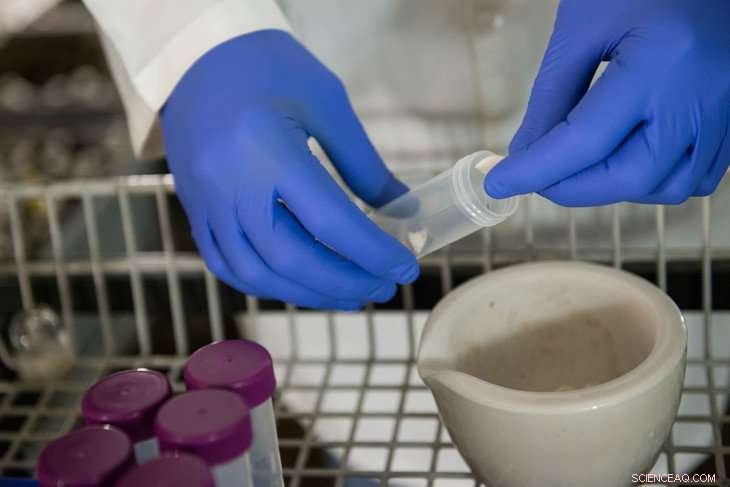
Mushroom slices are dropped into test tubes to be frozen in order to remove all moisture. Credit:Michelle Bixby
Secreted from the liver into the intestine, bile acids are responsible for digesting dietary fats and oils. "If you have a disorder in these types of processes then you have a really hard time digesting fat, " says Patterson.
To determine what was going on between the Lactobacillus and bile acids, Patterson turned to metabolomics—the study of the chemical fingerprints that are left behind after cellular processes take place. He learned that when the bile acid tauro-beta muricholic acid increases, it turns off the farnesoid X receptor (FXR), which is responsible for regulating the metabolism of bile acids, vetten, and glucose in the body. "FXR is there to say, 'Hallo, there's enough bile acid in the intestine, shut off synthesis in the liver, or there's not enough bile acid so synthesis needs to be turned on, '" says Patterson.
The revelation about FXR's involvement led Patterson and his colleagues at the Hershey Medical Center and the National Cancer Institute to design their own anti-obesity drug that specifically targets FXR. In less than two years, they created a pill, modeled after tauro-beta muricholic acid but made from glycine-beta muricholic acid, that caused mice to gain significantly less weight and have less insulin resistance when fed a high-fat diet than mice in the untreated control group.
Patterson received a RAIN grant from the college to help commercialize his product. He also formed a company, called Heliome Biotech, Inc., to commercialize the drug, along with any others that may arise. But Patterson cautions that although his drug has the potential to help patients, it isn't a cure-all. "I don't think this is going to be the magic pill that allows you to eat a tub of ice cream every day and not see any metabolic problems later in life, " he says. "You have to adopt a healthy lifestyle as well."
Lactobacillusisn't the only bacteria with strains that can cause problems.E. coli, te, which is common and generally benign throughout the human gut, includes at least one very dangerous strain—O157:H7. This bacterium enters the body through contaminated foods.
"One of the things that makes O157:H7 so terrible is when it gets in your intestines it produces a powerful toxin called Shiga toxin that is responsible for a lot of the serious symptoms of disease, from mild diarrhea to severe kidney damage, " says Edward Dudley, associate professor of food science. "The question is what's the difference between the people who only get diarrhea and those who get terribly sick?"
Dudley believes our gut microbiomes might hold the key to this question. "Could it be that different microorganisms in our gut—what I carry versus what you carry—could cause our reactions to O157:H7 to be different? After all, when O157:H7 enters our intestines, it's not existing there by itself; it's interacting with hundreds of microorganisms that are found in our gut. We are asking whether any of these organisms that O157:H7 finds itself setting up shop with do anything that may either increase or decrease the amount of toxin that the organism produces."
Those suspicions were confirmed when Chun Chen, een voormalig Ph.D. student of Dudley's, grew O157:H7 in the laboratory together with a variety of strains of common gut E. coli. "When grown together with O157:H7 some of them dramatically increase the amount of toxin that O157:H7 produces, suggesting what E. coli strains are in your intestines might actually play a role in dictating the course of the disease, " says Dudley.
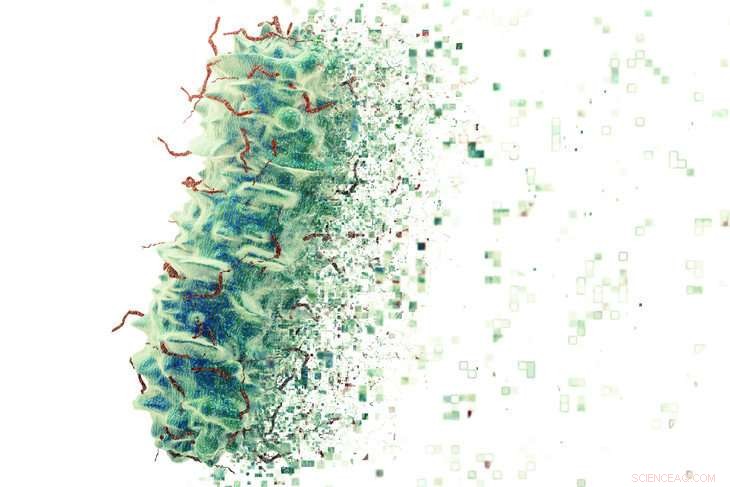
Edward Dudley, associate professor of food science in the College of Agricultural Sciences, and Chun Chen, een voormalig Ph.D. student of Dudley's, grew O157:H7 in the laboratory together with a variety of strains of common gut E. coli to confirm suspicions over whether or not the different microorganisms within in our gut could cause different reactions to this dangerous strain of bacteria. Their study suggests what E. coli strains are present in a person's intestines might actually play a role in dictating the course of the disease. Credit:iStock
Another one of Dudley's former students, Kakolie Goswami, along with a colleague from the University of Michigan, repeated the experiment using sterile mice that contained no bacteria. They inoculated those mice with O157:H7 and also with a nonpathogenic strain of E. coli that he'd previously shown in the laboratory to amplify Shiga toxin. They found the same result:the mice with the O157:H7 and the other strain of E. coli did worse than the mice with only O157:H7.
According to Dudley, antibiotics can't be used to treat O157:H7 the way they can with other bacteria. In feite, antibiotics actually increase the amount of Shiga toxin that the pathogen produces. Als resultaat, doctors simply monitor patients and treat their symptoms. "By knowing which E. coli strains a patient carries, doctors could predict the course of the disease in patients and be prepared with various treatments, " says Dudley. He adds that it also may be possible to use certain strains of E. coli as a probiotic that patients could ingest that would block the ability of O157:H7 to produce large quantities of toxin.
"Al decenia, we studied various bacteria growing as pure cultures in the lab, when in reality, whether it's human health or in the soils or oceans, no bacteria, except a very tiny number of them, exist by themselves, " says Dudley. "They are always in a community of other organisms. Now we're really beginning to pick apart just how an organism of interest behaves differently when it's in the presence of other organisms. There is much to learn."
Inderdaad, microbiome research is an open book with the potential to transform our lives. "We know now that microbiomes are driving more than we ever thought, " says Bull. "There is a wealth of information that we have only just begun to tap."
Bull notes that it's important for public institutions, like Penn State, to be involved in this type of research. "As a land-grant institution, Penn State is mandated to create knowledge for the greater good, " she says. "For example, if you talk to a farmer, he or she will tell you, 'This is my best soil; anything I grow here will be fine, ' but a hundred yards away, he or she might say, 'This is not a great spot, '" says Bull. "Farmers know the difference because they've seen the yields, but they do not know why one spot is great for their crops and the other is not. It's our job as scientists to do the research and give them the answer for that."
 Wat zijn de belangrijkste toepassingen van warmte-energie in de fysische wetenschap?
Wat zijn de belangrijkste toepassingen van warmte-energie in de fysische wetenschap?  Extreem hoge temperaturen gaan records breken:ANU-expert
Extreem hoge temperaturen gaan records breken:ANU-expert Australische supermarkt in zakken na plastic backflip
Australische supermarkt in zakken na plastic backflip Tropical Pacific is een belangrijke speler in het wereldwijde oceaanwarmtetransport
Tropical Pacific is een belangrijke speler in het wereldwijde oceaanwarmtetransport Onderzoeker beveelt systematische aanpak van bos- en watervoorzieningsbeheer aan
Onderzoeker beveelt systematische aanpak van bos- en watervoorzieningsbeheer aan
Hoofdlijnen
- Waar zijn spiervezels van gemaakt?
- Grafische Australische video van Japanse walvisvangst vrijgegeven
- Zelfs als je nog niet weet dat je ziek bent, je gezicht zal je verraden
- De reden voor incubatie bij verschillende temperaturen in de microbiologie
- Waarom hebben cellen voedsel nodig?
- Te veel zon is niet goed - voor mensen of planten
- Hoe Facebook kraakt over nepnieuws (en waarom nepnieuws werkt)
- Hoe werkt het skeletsysteem met het ademhalingsstelsel?
- Vissen krimpen als de temperatuur van de oceaan stijgt
- Komen soorten samen of divergeren ze naarmate ze evolueren?
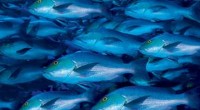
- Haaien evolueerden vliegtuigachtige attributen om in habitats te passen
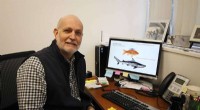
- Welk percentage botten in het lichaam bestaat uit het axiale skelet?
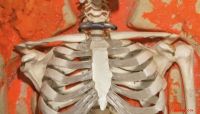
- Nieuwe analyse plaatst Hobbit op onverwachte ledemaat van de menselijke stamboom
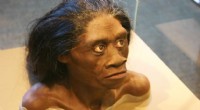
- Lemur-studie benadrukt de rol van voeding bij het vormgeven van het darmmicrobioom
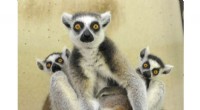
 Wetenschapper overbrugt de kloof tussen kwantumsimulators en kwantumcomputers
Wetenschapper overbrugt de kloof tussen kwantumsimulators en kwantumcomputers Eerste ontdekking van methanol in een warme planeetvormende schijf
Eerste ontdekking van methanol in een warme planeetvormende schijf Op hematiet gebaseerde nanodraadstructuren om de conversie van zonne-energie naar brandstof bij foto-elektrochemische watersplitsing te verbeteren
Op hematiet gebaseerde nanodraadstructuren om de conversie van zonne-energie naar brandstof bij foto-elektrochemische watersplitsing te verbeteren Embraer-aandelen stijgen nadat Bolsonaro de fusie met Boeing goedkeurt
Embraer-aandelen stijgen nadat Bolsonaro de fusie met Boeing goedkeurt Portugese brandweerlieden brengen bosbranden onder controle
Portugese brandweerlieden brengen bosbranden onder controle Optische vezels die de materialen eromheen kunnen voelen
Optische vezels die de materialen eromheen kunnen voelen Astrofysici bevestigen hoeksteen van Einsteins relativiteitstheorie
Astrofysici bevestigen hoeksteen van Einsteins relativiteitstheorie 18-jarige neemt deel aan Blue Origins 1e passagiersruimtevlucht
18-jarige neemt deel aan Blue Origins 1e passagiersruimtevlucht
- Elektronica
- Biologie
- Zonsverduistering
- Wiskunde
- French | Italian | Spanish | Portuguese | Swedish | German | Dutch | Danish | Norway |

-
Wetenschap © https://nl.scienceaq.com

